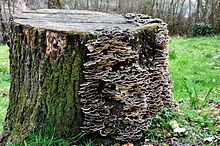Bring it on, ecosystem!
Fungi are capable of inhabiting incredibly diverse habitats.
They may be second only to the domain Archea in their
ability to inhabit harsh environments. To
accomplish this, they have evolved a lot of unique adaptations.
Saprophytes like Gyromitra esculenta have changed to fit their mode of nutrition.
_mycelium_in_petri_dish_on_coffee_grounds.jpg)
1. Branching mycelium:
The root-like mycelium (right) is made up
of hundreds of hyphal strands capable of moving through substrate
collecting nutrients. There are so many to
allow for increased uptake of water and food particles.
The more branched the mycelium, the greater its chance
for survival.
2. Decomposers:
Saprophytic fungi have it made.
Think about it: all they have to do is have a spore land
on something dead or dying and they’re golden.
The mycelium grows through the dead organism, like a
tree, collecting food. The fungus never has
to worry about its food source running away.
It also doesn’t care whether or not the sun is shining.
Unlike plants, they can grow in dark places because they
don’t need sunlight. This allows false morels
to occupy the interior of a fallen log, for example.
through the dead organism, like a
tree, collecting food. The fungus never has
to worry about its food source running away.
It also doesn’t care whether or not the sun is shining.
Unlike plants, they can grow in dark places because they
don’t need sunlight. This allows false morels
to occupy the interior of a fallen log, for example.
3. Folds on the cap:
You may have noticed how wrinkly and
folded the false morel’s cap is. This is not
a design flaw; it is actually an innovation.
The cap is convoluted to allow more surface area
for asci to form. The more asci, the
more spores. The more spores, the better the
mushroom’s chances of successful reproduction.
4. Poisonous: The false morel is toxic, as mentioned on
the home page. This modification protects it
from being eaten by potential animal predators as well as
intelligent
humans!
The toxicity page contains all the gory details about the how, when, and why of the false morel toxin. But before you learn all about the poison, be sure to visit the interactions page for some interesting ways this mushroom fits into its ecosystem.
Pictures on this page were taken from Wikipedia.com.
HOME